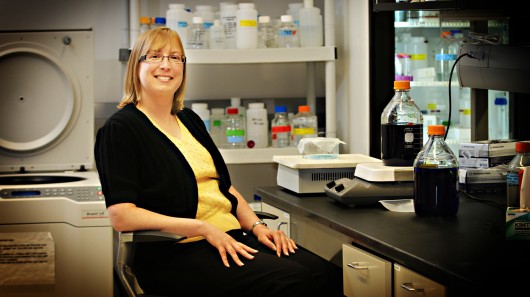Engineers at the University of Utah have developed and built the very first fuel cell using jet fuel that operates at room-temperature without the need to ignite the fuel. Using enzymes to help produce electricity, these new fuel cells have the potential to power everything from portable electronic devices to cars and off-grid power systems.
Engineers at the University of Utah have developed and built the very first fuel cell using jet fuel that operates at room-temperature without the need to ignite the fuel. Using enzymes to help produce electricity, these new fuel cells have the potential to power everything from portable electronic devices to cars and off-grid power systems.
Using Jet Propellent 8 (or JP-8, a kerosene-based jet fuel), the researchers used an enzymatic combination of alkane monooxygenase and alcohol oxidase to catalyze the fuel and speed up the chemical reactions occurring in the cell through a process known as mediated bioelectrocatalytic oxidation.
Tthat is, when enzymes are electrically connected to an electrode they oxidize materials, such as alcohols, organic acids, or – in this case, kerosene jet fuel – in the anode. In the cathode, substances such as molecular oxygen or hydrogen peroxide are subsequently reduced in this process and so, in combination with the reaction at the anode, generate electrical power.
This allowed the engineers to avoid past constraints associated with metal catalysts that would rapidly break down when exposed to sulfur-heavy compounds like kerosene.
"The major advance in this research is the ability to use Jet Propellant-8 directly in a fuel cell without having to remove sulfur impurities or operate at very high temperature," said Shelley Minteer, a University of Utah professor of materials science, engineering, and chemistry. "This work shows that JP-8 and probably others can be used as fuels for low-temperature fuel cells with the right catalysts."
In the new study, the University of Utah team concentrated their research on JP-8 as it is a common fuel used by the US military in harsh conditions, such as the extreme heat encountered in deserts or the sub-zero temperatures found in arctic regions. Hexane and octane, which are chemically comparable to JP-8, were also tested in the fuel cell and shown to work in a comparable fashion. Further experiments by the researchers also found that adding sulfur did not reduce power production in the enzymatic fuel cell as it did in a standard metal-catalyst device.
"Enzymatic fuel cells are a newer type of fuel cell, so they are not currently on the market," said Professor Minteer. "However, researchers haven’t been able to use JP-8 before, because they haven’t had the enzymes to be able to oxidize JP-8."
We've seen fuel cells that utilize solid oxide in the past – such as a fuel cell developed by Fraunhofer – but these and similar devices are only capable of producing electricity by igniting the fuel and operating at very high temperatures.
Similarly, JP-8-powered fuel cells have also been produced, but they only worked by running at temperatures of over 950° F (510° C). The new system is unique in that it produces and sustains its electricity-generating process at room temperature and without the need to ignite the fuel, making it much safer to use in the likes of motor vehicles and small devices.
With power densities of up to 3 mW/cm2 achieved using the JP-8 fuel – and without the desulfurization required in standard fuel cells employing metal catalysts – the researchers hope that further advances in size and capacity will see the units taken up widely in both military and civilian use. However, no announcement has been made as to the eventual commercialization and release of this new fuel cell device.
The study was financed by Northrop Grumman and the National Science Foundation working through the University of Utah’s Materials Research Science and Engineering Center, with the research published in the
Source:
gizmag


 Previous page
Previous page Back to top
Back to top







